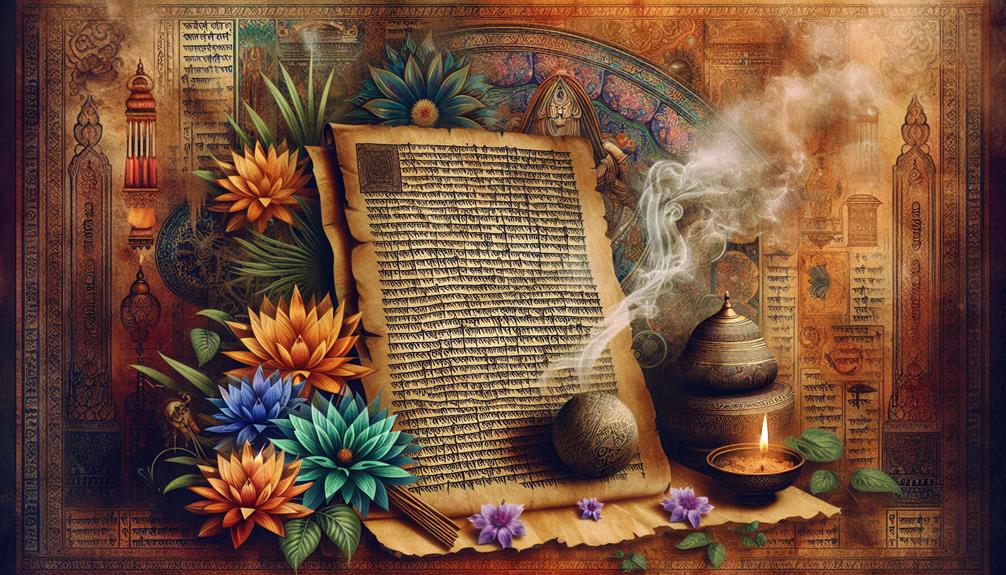Scholars have long debated the true nature of the Kama Sutra and its relationship to Hinduism. While commonly associated with Hindu culture due to its mention in Vedic texts and its emphasis on dharma (duty), artha (prosperity), kama (pleasure), and moksha (liberation), the nuanced origins of the text suggest a more complex narrative.
Is The Kama Sutra A Hindu Book?
By examining the historical context, cultural influences, and misconceptions surrounding the Kama Sutra, a deeper understanding of its connection to Hindu philosophy emerges. However, the exploration of this topic goes beyond mere religious categorization, inviting a closer look at the multifaceted dimensions of this ancient text.
Is The Kama Sutra A Hindu Book?
Key Takeaways
- The Kama Sutra is deeply rooted in Hindu philosophy and culture.
- It reflects Hindu values of dharma, artha, kama, and moksha.
- The text offers guidance on relationships, love, and societal norms within a Hindu context.
- Understanding the Kama Sutra requires acknowledging its Hindu origins and philosophical underpinnings.
The Origins of the Kama Sutra
The roots of the Kama Sutra, an ancient Indian text on human sexual behavior and relationships, can be traced back to the scholarly traditions of Hindu philosophy and culture. Composed by Vatsyayana, the Kama Sutra is believed to have been written between the 2nd and 4th centuries CE. While often associated with sexuality, the Kama Sutra is much more than a mere guide to physical intimacy; it encompasses a holistic approach to relationships, encompassing love, family life, and social interactions.
Is The Kama Sutra A Hindu Book?
Within Hindu philosophy, the Kama Sutra is considered a treatise on the three pillars of life: dharma (duty), artha (material success), and kama (pleasure). It emphasizes the importance of balance and harmony between these aspects to lead a fulfilling and virtuous life. The text explores various aspects of human nature, desires, and relationships, offering guidance on how individuals can navigate the complexities of love and intimacy within societal norms and personal ethics.
Is The Kama Sutra A Hindu Book?
Cultural Influences and Interpretations
Influenced by a myriad of cultural perspectives, the Kama Sutra has been subject to diverse interpretations throughout history. This ancient Indian text on human sexual behavior and relationships has been viewed through various lenses, each shaped by the cultural context of the interpreters. In the Western world, the Kama Sutra is often sensationalized and reduced to a manual of exotic sexual positions, overlooking its broader teachings on love, intimacy, and connection. On the other hand, in traditional Indian society, the Kama Sutra is seen as a holistic guide to a fulfilling life encompassing not just physical pleasure but also emotional and spiritual fulfillment.
Is The Kama Sutra A Hindu Book?
Over time, the Kama Sutra has been reinterpreted and reimagined in different cultural settings, reflecting changing attitudes towards sexuality and relationships. In contemporary times, the text continues to spark discussions on the intersection of culture, tradition, and modernity, inviting individuals to explore its teachings in the context of their own lives and beliefs.
Is The Kama Sutra A Hindu Book?
Historical Context and Hindu Connections
Closely intertwined with the historical context of ancient India, the Kama Sutra’s Hindu connections provide insight into the cultural and religious foundations that shaped this seminal text on human relationships and sexuality.
Is The Kama Sutra A Hindu Book?
The Kama Sutra, attributed to Vatsyayana, dates back to around the 2nd century CE, a period when Hinduism was flourishing in India. Hinduism, with its complex tapestry of beliefs and practices, influenced various aspects of society, including norms around relationships, marriage, and eroticism.
The text itself is not merely a guide to physical intimacy but encompasses a broader view of human existence, emphasizing dharma (duty), artha (material success), kama (pleasure), and moksha (liberation). These principles are deeply rooted in Hindu thought, reflecting the interconnectedness of physical desires with spiritual aspirations.
Through its teachings on love, intimacy, and pleasure, the Kama Sutra mirrors the Hindu worldview that acknowledges the importance of embracing all facets of human experience in the pursuit of a fulfilling life.
Misconceptions and Modern Perceptions
Misunderstandings and contemporary viewpoints often cloud the true essence and significance of the Kama Sutra in today’s society. Despite its historical roots and cultural importance, misconceptions persist regarding this ancient text. Here are three key points to consider:
- Misinterpretation: The Kama Sutra is commonly misconstrued as a mere manual for physical intimacy. In reality, it is a comprehensive guide to a well-rounded life, encompassing relationships, social behavior, and personal growth.
- Cultural Stereotypes: Many modern perceptions of the Kama Sutra are influenced by Western exoticism and sensationalism, leading to a skewed understanding of its original purpose and teachings.
- Evolution of Interpretation: Over time, the Kama Sutra has been reinterpreted and adapted to fit various cultural contexts, sometimes deviating from its authentic intentions. Understanding these shifts in interpretation is crucial for a more nuanced view of the text’s significance in contemporary society.
The Kama Sutra Beyond Religion
The Kama Sutra transcends religious boundaries to offer timeless insights into human relationships and personal development. This ancient text goes beyond the confines of any single religion, making its teachings universally applicable to all individuals seeking to enhance their intimate connections and self-awareness. By delving into the Kama Sutra’s principles, individuals can discover profound wisdom that enriches their understanding of love, passion, and human nature.
Table: Key Aspects of the Kama Sutra Beyond Religion
| Aspect | Description | Benefit |
|---|---|---|
| Emphasis on Respect | Focuses on mutual respect between partners | Cultivates a harmonious relationship |
| Exploration of Desires | Encourages open communication about desires | Enhances intimacy and emotional connection |
| Self-Discovery | Promotes self-awareness and personal growth | Fosters individual development and fulfillment |
Through these core aspects, the Kama Sutra serves as a guide for individuals seeking to navigate the complexities of relationships and deepen their understanding of themselves and their partners, transcending religious boundaries to offer profound insights into the human experience.
Frequently Asked Questions
How Has the Kama Sutra Influenced Contemporary Popular Culture and Media?
The Kama Sutra has significantly influenced contemporary popular culture and media by shaping perceptions of sensuality and intimacy. Its teachings have been incorporated into various forms of art, literature, and entertainment, contributing to a more open and liberated discussion on human relationships.
The Kama Sutra’s emphasis on pleasure, communication, and mutual respect continues to inspire modern interpretations in films, music, fashion, and other creative outlets, fostering a broader understanding of love and desire.
Are There Any Lesser-Known Texts or Resources That Provide Additional Insights Into the Practices Mentioned in the Kama Sutra?
Exploring lesser-known texts can offer deeper insights into the practices mentioned in the Kama Sutra. Sources like the Ananga Ranga, Ratirahasya, and Jayamangala provide additional perspectives on intimate relationships, eroticism, and pleasure.
These texts complement the Kama Sutra by offering diverse cultural viewpoints and historical context. Delving into these resources can enrich one’s understanding of ancient sexual practices and philosophies beyond the well-known Kama Sutra.
What Role Did Women Play in the Creation and Dissemination of the Kama Sutra?
Women played a significant role in the creation and dissemination of the Kama Sutra. They were not only subjects of the text but also contributors to its knowledge. Through their involvement in various aspects of society, women added valuable insights and perspectives to the text, shaping its content and ensuring its transmission across generations.
Their influence on the Kama Sutra highlights the importance of their participation in cultural and intellectual endeavors.
How Has Globalization Impacted the Understanding and Reception of the Kama Sutra in Non-Indian Cultures?
Globalization has significantly influenced the perception and reception of the Kama Sutra in non-Indian cultures by disseminating diverse interpretations and adaptations of the text.
The wider accessibility of information and cultural exchange has led to varying understandings of the Kama Sutra, sometimes shifting its portrayal from a traditional Indian text on love and relationships to a more mainstream guide on sexual practices.
This globalization has both enriched and altered the way the Kama Sutra is perceived globally.
Are There Any Ongoing Debates or Controversies Surrounding the Authenticity or Authorship of the Kama Sutra?
Ongoing debates and controversies envelop the authenticity and authorship of the Kama Sutra, with scholars and historians delving into the intricate layers of its origins.
As varying perspectives clash, questions arise regarding the true identity behind this ancient text and its intended purpose.
Through rigorous analysis and academic discourse, the quest to unravel the mysteries surrounding the Kama Sutra continues, shedding light on its enigmatic past and shaping the discourse on its significance in the realm of literature and cultural studies.
Conclusion
In conclusion, the Kama Sutra, often misunderstood as a solely Hindu text, actually draws from diverse cultural influences and historical contexts. While it does have connections to Hinduism, it is not exclusively a Hindu book.
The misconceptions surrounding the Kama Sutra have shaped modern perceptions of its content and purpose. By exploring the text beyond religious boundaries, we can appreciate its significance as a guide to human relationships and sexuality.

